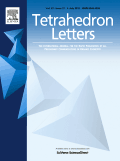
TETRAHEDRON LETTERS
Scope & Guideline
Elevating Chemical Research to New Heights
Introduction
Aims and Scopes
- Synthetic Methodologies:
Research that develops and optimizes synthetic routes for organic compounds, including novel reactions, catalysts, and conditions. - Organocatalysis:
Studies centered on the use of organocatalysts in various organic transformations, emphasizing green chemistry and sustainability. - Medicinal Chemistry:
Investigations into the synthesis and biological evaluation of compounds with potential pharmaceutical applications, including anticancer and antimicrobial agents. - Material Chemistry:
Research focused on the synthesis and characterization of new materials, including polymers and nanocomposites, with applications in electronics and photonics. - Natural Product Synthesis:
Total syntheses and synthetic strategies for complex natural products, exploring their biological activities and medicinal applications. - Photocatalysis and Electrochemistry:
Studies that utilize light or electrochemical methods to drive organic reactions, promoting efficiency and selectivity in synthesis. - Heterocyclic Chemistry:
Research dedicated to the synthesis and functionalization of heterocyclic compounds, which are crucial in pharmaceuticals and agrochemicals. - Mechanistic Studies:
Investigations into the mechanisms of chemical reactions, providing insights that can guide the development of new synthetic methods.
Trending and Emerging
- Sustainable and Green Chemistry:
There is a growing emphasis on sustainable practices, including the use of renewable resources, waste reduction, and energy-efficient processes in organic synthesis. - Photoredox and Electrochemical Catalysis:
Research involving photoredox catalysis and electrochemical methods has surged, highlighting innovative approaches to organic transformations under mild conditions. - Asymmetric Synthesis and Catalysis:
There is an increasing number of studies focused on asymmetric synthesis, particularly involving novel chiral catalysts and methodologies that enhance enantioselectivity. - Artificial Intelligence in Synthesis:
Emerging interest in integrating AI and machine learning techniques into synthetic organic chemistry to predict reaction outcomes and optimize synthetic routes. - Bioorthogonal Chemistry:
The development of bioorthogonal reactions that facilitate the labeling and tracking of biomolecules in live systems is gaining traction, particularly in medicinal chemistry. - Nanotechnology in Drug Delivery:
Research exploring the use of nanomaterials for drug delivery systems is on the rise, reflecting the interdisciplinary nature of modern chemical research. - Functionalization of Natural Products:
There is an increasing trend toward the functionalization and modification of natural products to enhance their biological activity and potential therapeutic applications.
Declining or Waning
- Traditional Metal Catalysis:
While metal-catalyzed reactions remain important, there has been a noticeable decline in studies focusing solely on traditional metal catalysts, as researchers increasingly explore greener and more sustainable alternatives. - Conventional Organic Solvents:
Research emphasizing the use of traditional organic solvents has decreased, with a growing preference for solvent-free or environmentally friendly methods being favored. - Two-Dimensional Materials:
The focus on synthesis and applications of two-dimensional materials, such as graphene and transition metal dichalcogenides, has waned as interest shifts towards more complex and functional materials. - Biological Mechanisms of Action:
Research papers dedicated solely to elucidating the biological mechanisms of action of compounds without a strong synthetic component seem to be less frequent.
Similar Journals
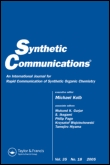
SYNTHETIC COMMUNICATIONS
Connecting Innovators in the World of Organic SynthesisSynthetic Communications, published by Taylor & Francis Inc, stands as a pivotal resource in the field of organic chemistry since its inception in 1971. With an ISSN of 0039-7911 and an E-ISSN of 1532-2432, this journal has established a commendable reputation, holding a Q3 ranking in organic chemistry by 2023, reflecting its contributions to the discipline and positioning it within the 50th percentile according to Scopus rankings. Targeted towards researchers, professionals, and students alike, Synthetic Communications aims to disseminate significant advancements in synthetic methodologies and reactions, facilitating the exchange of innovative ideas and enhancing collaborative efforts in the scientific community. Although not an open-access journal, it offers a wealth of valuable research content that is crucial for anyone dedicated to pushing the boundaries of organic chemistry.

BIOORGANIC & MEDICINAL CHEMISTRY LETTERS
Delivering essential knowledge in bioorganic chemistry.BIOORGANIC & MEDICINAL CHEMISTRY LETTERS, published by PERGAMON-ELSEVIER SCIENCE LTD, is a leading journal in the fields of biochemistry, drug discovery, and medicinal chemistry, designed to disseminate significant advances in these disciplines. Established in 1991, the journal spans various important categories, including Organic Chemistry and Pharmaceutical Science, with its 2023 Scimago Journal Rank placing it at Q2 in Organic Chemistry and Q3 in several other relevant fields. Though not an open-access publication, it provides invaluable insights into contemporary research and innovative methodologies, appealing to researchers, professionals, and students alike. The journal's commitment to quality and relevance makes it a vital resource for those aiming to stay at the forefront of bioorganic and medicinal chemistry developments. For more information, please visit the journal's website as it remains a critical platform for scholarly exchange, particularly for those engaged in interdisciplinary research.
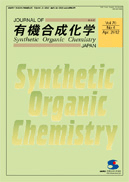
JOURNAL OF SYNTHETIC ORGANIC CHEMISTRY JAPAN
Pioneering research in the heart of organic synthesis.JOURNAL OF SYNTHETIC ORGANIC CHEMISTRY JAPAN, published by the SOCIETY OF SYNTHETIC ORGANIC CHEMISTRY, JAPAN, is an esteemed publication specializing in the dynamic field of organic chemistry. With a rich history dating back to 1944, this journal aims to disseminate pivotal research findings and innovative methodologies in synthetic organic chemistry, fostering collaboration and knowledge exchange among researchers and professionals. Although it currently holds a modest ranking in the Q4 quartile for organic chemistry, its commitment to advancing the discipline remains steadfast. The journal primarily caters to scholars and students seeking to delve deeper into organic synthesis, highlighting original articles, reviews, and methodological studies. While access to the journal is not open, its contributions to the field are essential for anyone invested in understanding the complexities of organic chemistry. We invite you to explore the journal's offerings and enhance your expertise in synthetic organic processes.
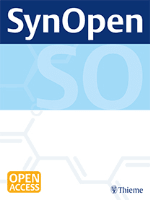
SynOpen
Catalyzing Ideas, Enriching ResearchSynOpen is an esteemed open-access journal published by GEORG THIEME VERLAG KG, based in Germany, dedicated to advancing the fields of Biomaterials, Catalysis, Materials Science, and Organic Chemistry. Since its inception in 2017, the journal has established itself as a vital platform for researchers wishing to disseminate their findings in a rapidly evolving scientific landscape, earning a commendable Q2 ranking in Materials Science (miscellaneous) and Q3 in other key categories for 2023. With an increasing impact on its disciplines, SynOpen aims to foster interdisciplinary collaboration and innovation by providing unrestricted access to high-quality research, thus promoting a broader reach and visibility for authors. Scholars, professionals, and students alike can benefit from the comprehensive range of topics covered, as the journal's commitment to presenting cutting-edge studies and methodologies positions it as a crucial resource for contemporary scientific inquiry.

Heterocyclic Letters
Fostering Excellence in Heterocyclic Compound StudiesHeterocyclic Letters is an esteemed journal in the field of synthetic organic chemistry, published by RAMAN PUBL. With ISSN 2231-3087 and E-ISSN 2230-9632, this journal aims to disseminate original research and innovative findings related to heterocyclic compounds, which play a crucial role in medicinal chemistry, material science, and agricultural chemistry. Heterocyclic Letters provides a platform for researchers, professionals, and students to share their insights and advancements, thus fostering academic collaboration and knowledge transfer. The journal is dedicated to maintaining high-quality standards in research publication, making it an essential resource for anyone focused on the latest developments in heterocyclic chemistry. Although it does not currently offer Open Access options, the journal’s rigorous peer-review process ensures that only the most credible and impactful studies are published, contributing significantly to the advancement of the field.
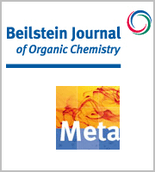
Beilstein Journal of Organic Chemistry
Fostering innovation through open access to organic chemistry.The Beilstein Journal of Organic Chemistry, published by the renowned BEILSTEIN-INSTITUT, stands as a pivotal platform for advancing the field of organic chemistry since its inception in 2005. With its commitment to Open Access publishing, this journal enables global readership and collaboration, fostering the dissemination of high-quality research. Operating from Germany, the journal has carved out a significant reputation, currently holding a Q2 ranking in the Organic Chemistry category, with impressive Scopus rankings placing it at #91 out of 211 in the field, achieving a 57th percentile. The Beilstein Journal is dedicated to publishing cutting-edge findings that span the breadth of organic chemistry, including synthetic methodologies, catalysis, and material sciences, making it an essential resource for researchers, professionals, and students looking to stay at the forefront of organic chemistry advancements. With a vision to enhance collaboration and knowledge sharing within the scientific community, the journal plays a vital role in shaping the future of organic chemistry research.

JOURNAL OF HETEROCYCLIC CHEMISTRY
Charting the Future of Organic ChemistryJournal of Heterocyclic Chemistry, published by Wiley, stands as a key resource in the field of organic chemistry, offering in-depth research articles and insights spanning from 1966 to 2024. With its strong Scopus ranking of #83 out of 211 in the Organic Chemistry category, placing it in the 60th percentile, the journal maintains its significance and relevance within the academic community. Although it does not currently offer open access options, it provides extensive coverage of heterocyclic compounds, which are vital to various applications in pharmaceuticals and material sciences. The journal's commitment to high-quality research is further reflected in its classification as Q3 in the 2023 quartiles for Organic Chemistry. Researchers, professionals, and students alike will find valuable contributions to the intricate studies of heterocycles, enhancing their understanding and exploration of this fascinating area of chemistry.
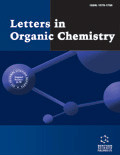
LETTERS IN ORGANIC CHEMISTRY
Connecting Minds in Organic ChemistryLETTERS IN ORGANIC CHEMISTRY is a distinguished journal published by Bentham Science Publishers Ltd, focusing on the rapidly evolving field of organic chemistry. Established in 2005, the journal commits itself to disseminating vital research findings, reviews, and innovative methodologies that contribute to the understanding and advancement of organic chemistry and biochemistry. With an ISSN of 1570-1786 and an E-ISSN of 1875-6255, this journal enhances accessibility and visibility for authors and readers alike, albeit not adopting an open-access model. Positioned within Q4 quartile rankings for both Biochemistry and Organic Chemistry, it serves a niche audience keen on exploring emerging trends and breakthroughs in these disciplines. Its Scopus rankings further reflect its role in the global academic landscape, albeit at the beginning stages of its impact journey. Based in the United Arab Emirates, LETTERS IN ORGANIC CHEMISTRY is dedicated to fostering dialogue among researchers and practitioners, paving the way for future innovations in organic and biochemical sciences.
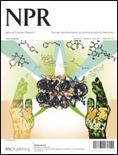
NATURAL PRODUCT REPORTS
Exploring the Essence of Nature's ChemistryNATURAL PRODUCT REPORTS, published by the Royal Society of Chemistry, is a premier interdisciplinary journal that specializes in the field of natural product chemistry. With an impressive impact reflected in its 2023 quartile rankings, it holds a Q1 status in key categories including Biochemistry, Drug Discovery, and Organic Chemistry, highlighting its significance and influence in these areas. The journal, which has been disseminating groundbreaking research since its inception in 1984, serves as a vital resource for researchers, professionals, and students dedicated to advancing the understanding and application of natural products in various scientific contexts. Although it does not offer open access, the journal provides a plethora of insightful reviews and seminal articles that contribute to the collective knowledge and innovation within the natural product community. With a commitment to excellence, NATURAL PRODUCT REPORTS continues to foster collaboration and inspire future breakthroughs in the field.

HELVETICA CHIMICA ACTA
Empowering Researchers with Peer-Reviewed ExcellenceHELVETICA CHIMICA ACTA, published by WILEY-V C H VERLAG GMBH, stands as a pivotal journal in the fields of chemistry and chemical research. Established in 1918, this esteemed journal spans a diverse array of topics, including biochemistry, catalysis, drug discovery, inorganic and organic chemistry, as well as physical and theoretical chemistry. With influence reflected in its noteworthy Q2 and Q3 quartile rankings across these categories as of 2023, HELVETICA CHIMICA ACTA continues to capture the interest of the global scientific community. Although not an open-access journal, it remains accessible through various academic institutions, ensuring broad reach and collaboration opportunities. Researchers, professionals, and students alike will find its meticulously peer-reviewed articles critical for advancing knowledge and fostering innovation within the chemical sciences. As the journal converges toward 2024, it remains committed to publishing high-quality, impactful research that supports the evolution of chemistry across its multifaceted disciplines.